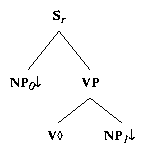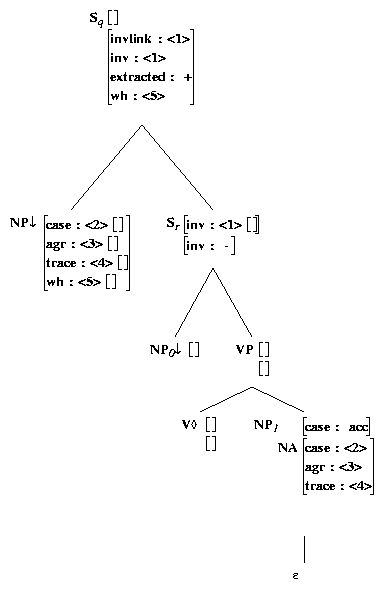
 |

The semantic interpretation of arguments across different trees in a family remains constant. That is, if is the recipient argument of the predicate in the base indicative tree, then it is the recipient when it is fronted as well. There are some syntactic transformations, however, that are sensitive to the properties of a particular word within the same subcategorization frame. The ergative (or transitive-inchoative alternation) for transitive verbs is one such transformation. Only a subset of the transitive verbs can undergo this transformation. Let us call such transformations lexical rules to distinguish them from more general syntactic transformations (like wh-extraction) which are not lexically idiosyncratic. To explain how these two different kinds of transformations interact let us take the example of the ergative subset of the transitive verbs: Ergative verbs such as melt undergo the ergative transformation (see Chapter 7). Such verbs are a subset of the set of transitive verbs, which do not all take this transformation; for example verbs like borrow cannot take this transformation. To handle the transitive/ergative distinction, we could create a tree family which exclusively handles the regular transitives and another one which handles the ergatives. In doing so, however, we would be duplicating structure since the ergative family would contain all of the trees found in the transitive family in addition to the purely ergative trees. An alternative is to consider the ergative distinction as arising from a lexical rule which takes the base tree of the transitive family (nx0Vnx1) and produces the base tree for a strictly ergative family (Enx1V). Then all of the syntactic transformations which are available in the grammar can be applied to that new base tree to form the entire ergative tree family. In this particular instance, the indexation on the syntactic object NP of nx0Vnx1 ( ) is retained on the syntactic subject of the ergative tree, which has the same semantic role in both constructions. The same problem appears in the ditransitive tree family, in which a subset of anchors also undergo the dative-shift transformation. We give an identical solution to this case as we do for the ergatives. Hence, tree families can be related to each other by lexical rules. Construing tree families in this way allows us to take advantage of shared structure when creating a grammar. Introducing this shallow hierarchy in the definition of family allows us to have a more compact organization of the grammar. This departs from earlier conceptions of tree families which maintained that argument positions in different tree families were in no way related; thus, before, if a lexical item anchored two different tree families, each anchoring instance was considered a different predicate. Under both the previous and the present conceptions, tree families are the exhausitive domain of a base tree and the trees generated by syntactic transformations on that base. However, the present conception of tree families provides for a new level of distinction - that of families related by a lexical rule. These related families are the exhaustive domain of a particular predicate that is affected by a lexical rule. The XTAG grammar encodes the notion of lexical rules implicitly rather than explicitly. It is implicit in the anchorings of certain lexical items. For example, ergative verbs such as melt anchor both Tnx0Vnx1 and TEnx1V, and their lexical family is the set of trees in the union of these two tree families. See the chapters on ergatives (see Chapter 7) and ditransitives (see Chapter 10) for more in-depth discussions of particular cases of lexical families. To briefly summarize, we can now give the following definitions: